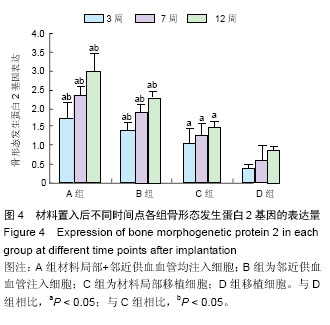| [1] Maria-Pau G,Cristina C,Montserrat E,et al.Calcium phosphate cements as drug delivery materials.Science Direct.2012;64(12):1090-1100.[2] Alves Cardoso D,Jansen JA,Leeuwenburgh S.Synthesis and application of nanostruc- tured calcium phosphate ceramics for bone regeneration. J Biomed Mater Res. 2012;11(8):2316-2326.[3] Felix Lanao R,Hoekstra J,Wolke C,et al. Porous calcium phosphate cement for alveolar bone regeneration.J Tissue Eng Regen Med. 2014;8(6):473-482.[4] Zeng D,Xia L,Zhang W,et al.Maxillary sinus floor elevation using a tissue-engineered bone with calcium-magnesium phosphate cement and bone marrow stromal cells in rabbits.Tissue Eng Part A.2011; 18(7-8): 870-881.[5] Liu R,Wu XX,Li J,et al.The promotion of bone tissue regeneration by BMP2-derived peptide P24-loaded calcium phosphate cement microspheres.Ceram Int.2015.[6] Zhang XD,Zou P,Wu C,et al.A study of porous block HA ceramics and it sost eogeneses.In: Bioceramics and the Human Body.ED by Ravaglioli and Krajewski. Elsevier Applied Science,1991:408.[7] Udehiya RK,Amarpal,Aithal HP,et al.Comparison of autogenic and allogenic bone marrow derived mesenchymal stem cells for repair of segmental bone defects in rabbits. Res Vet Sci. 2013;94(3):742-752.[8] Park SY,Kim KH,Shin SY,et al.Dual delivery of rhPDGF-BB and bone marrow mesenchymal stromal cells expressing the BMP2 geneenhance bone formation in a critical-sized defect model.Tissue Eng Part A.2013;19(21-22):2495-2505.[9] Songa G,Habibovicb, PBaoa C,et al.The homing of bone marrow MSCs to non-osseous sites for ectopic bone formation induced by osteoinductive calcium phosphate. Biomaterials.2013;34(9):2167-2176.[10] Phinney DG.Isolation of mesenchymal stem cells from murine bone marrow by immunodepletion.Methods Mol Biol.2008;449:171-186.[11] Park BN,Shim W,Lee G,et al.Early distribution of intravenously injected mesenchymal stem cells in rats with acute brain trauma evaluated by 99m Tc-HMPAO labeling.Nucl Med Biol. 2011;38(8): 1175-1182.[12] Wang PP,Wang JH,Yan ZP,et al.Expression of hepatocyte-like phenotypes in bone marrow stromal cells after HGF induction.Biochem Biophys Res Commun.2004;320(3): 712-716.[13] 张双燕,谢幼专,薛文东,等.塑料包埋技术在骨组织研究中的应用[J].现代临床医学生物工程学杂志, 2007,12(5): 430-432.[14] Rawadi G,Vayssire B,Dunn F,et al.BMP-2 controls alkaline phosphatase expression and osteoblast mineralization by a Wnt autocrine loop.J Bone Miner Res.2003;18(10): 1842-1853.[15] Lee JB,Kuroda S,Shichinohe H,et al.Migration and differentiation of nuclear fluorescence‐labeled bone marrow stromal cells after transplantation into cerebral infarct and spinal cord injury in mice. Neuropathology. 2003;23(3):169-180.[16] Li B,Liao X,Zheng L.Effect of nanostructure on osteoinduction of porous biphasic calcium phosphate ceramics.Acta Biomater.2012;8(10):3794-3804.[17] De Groot J.Carriers that concentrate native bone morphogenetic protein in vivo.Tissue Eng. 1998;4: 337-341.[18] Zhang J,Luo X,Barbieri D,et al The size of surface microstructures as an osteogenic factor in calcium phosphate ceramics.Acta Biomater. 2014;10(7): 3254-3263. [19] Hattori S.Structural features of ectopic bone-like tissue in porous hydroxyapatite blocks.Kokubyo Gakkai Zasshi. 2008,75(2):120-137.[20] Derubeis AR,Cancedda R.Bone marrow stromal cells (BMSCs) in bone engineering: limitations and recent advances.Ann Biomed Eng.2004;32(1):160-165.[21] Sun X,Zhang Z,Wang S,et al.Maxillary sinus floor elevation using a tissue- engineered bone complex with OsteoBone™ and bMSCs in rabbits. Clin Oral Implants Res.2008;19(8):804-813.[22] Jang JH,Castano O,Kim HW.Electrospun materials as potential platforms for bone tissue engineering.Adv Drug Deliv Rev.2009;61(12):1065-1083.[23] Zou D,Zhang Z,He J,et al.Blood vessel formation in the tissue-engineered bone with the constitutively active form of HIF-1α mediated BMSCs.Biomaterials. 2012; 33(7): 2097-2108.[24] 赵天源,孙 红.骨组织工程支架材料及其血管化的研究进程[J].中国组织工程研究,2013, 17(38):6832-6838. [25] Ude CC,Shamsul BS,Ng MH,et al.Bone marrow and adipose stem cells can be tracked with PKH-26 until post staining passage 6 in in vitro and in vivo.Tissue Cell.2012; 44(3):156-163.[26] Yang HN,Park JS,Na K,et al.The use of green fluorescence gene(GFP)-modified rabbit mesenchymal stem cells(rMSCs) coculturedwith chondrocytes in hydrogel constructs to reveal the chondrogenesisof MSCs.Biomaterials.2009;30(31):6374-6385. [27] Li Y,McIntosh K,Chen J,et al.Allogeneic bone marrow stromal cells promote glial–axonal remodeling without immunologic sensitization after stroke in rats.Exp Neurol.2006;198(2):313-325. [28] Taupin P. BrdU immunohistochemistry for studying adult neurogenesis: paradigms, pitfalls, limitations, and validation.Brain Res Rev.2007;53(1):198-214.[29] 金世柱,韩明子,曲波,等.PKH26 荧光示踪剂在小鼠骨髓单个核细胞肝内迁移过程中标记作用的研究[J].胃肠病学和肝病学杂志,2008,17(1):33-35.[30] Nagyova M,Slovinska L,Blasko J,et al.A comparative study of PKH67,DiI,and BrdU labeling techniques for tracing rat mesenchymal stem cells.In Vitro Cell Dev Biol Anim.2014;50(7):656-663. [31] Li M,Liu XY,Liu XD,et al.Creation of macroporous calcium phosphate cements as bone substitutes by using genipin-crosslinked gelatin microspheres.Mater Med. 2009;20(4):925-934. [32] Kasten P,Voge J,Luginbüh R,et al.Influence of platelet-rich plasma on osteogenic differentiation of mesenchymal stem cells and ectopic bone formation in calcium phosphate ceramics.Cells Tissues Organs. 2006;183(2):68-79.[33] Luu HH,Song WX,Luo XJ,et al.Distinct roles of bone morphogenetic proteins in osteogenic differentiation of mesenchymal stem cells.J Orthopaedic Res.2007; 25(5): 665-77.[34] 徐俊,殷潇凡,谷辉杰,等.磷酸三钙填充骨缺损后骨形态发生蛋白和血管内皮生长因子的变化[J].中国组织工程研究,2014,18(43):6959-6965.[35] Gu W,Zhang F,Xue Q,et al.Transplantation of bone marrow mesenchymal stem cells reduces lesion volume and induces axonal regrowth of injured spinal cord. Neuropathology.2010;30(3):205-217.[36] Zhao DC,Lei JX,Chen R,et al.Bone marrow-derived mesenchymal stem cells protect against experimental liver fibrosis in rats.World J Gastroenterol.2005; 11(22): 3431-3440.[37] Tang Z,Wang Z,Qing F,et al.Bone morphogenetic protein Smads signaling in mesenchymal stem cells affected by osteoinductive calcium phosphate ceramics. Biomed Mater Res A. 2015;103(3):1001- 1006. |
.jpg)





.jpg)
.jpg)
.jpg)